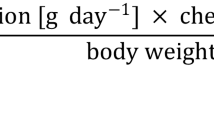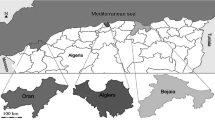Abstract:
Concentrations of polychlorinated dibenzodioxins, dibenzofurans and dioxin-like PCBs in the edible part of fish and in fishery products were studied to gain an overview on actual contaminant levels on the German market.
The investigation focused mainly on fish species with higher fat content and was orientated to cover all important fishing grounds for the supply of the German market. Pooled samples of 32 different fish species, 5 crustacean and mussel species and some typical products were analysed. Fish with low and moderate fat content kept on average below 1 ng Sum WHO-PCDD/FPCB-TEQ ng kg−1 wet weight and fish with high fat content (>10%) ranged between 1 to 3 ng kg−1 w.w.. A dependence of the WHO-TEQ concentrations in the muscle meat to the fishing ground was observed for several species. Ocean perch and Greenland halibut from the northern North Sea and fatty fish species from the Baltic Sea and the English Channel south of Great Britain had higher contaminant concentrations compared to corresponding fishes from other fishing grounds. The temporal trends of dioxin concentrations in mackerel and ocean perch are discussed.
Zusammenfassung:
Die vorliegende Studie gibt einen aktuellen Überblick zur Belastungssituation von Fischen und Fischereierzeugnissen auf dem deutschen Markt mit polychlorierten Dibenzodioxinen, Dibenzofuranen und dioxinähnlichen PCB. Untersucht wurden vor allem Fische mit höheren Fettgehalten unter Berücksichtigung der für den deutschen Markt wichtigen Fanggebiete.
Insgesamt wurden 32 Fischarten, 5 Krebs- und Weichtierarten und verschiedene typische Produkte analysiert. Die Gesamtgehalte (WHO-TEQ) in Fischen mit niedrigen und mittleren Fettgehalten lagen im Allgemeinen unter 1 ng WHO-PCDD/FPCB-TEQ kg−1 Frischgewicht, Fische mit höheren Fettgehalten (>10%) lagen bei 1 – 3 ng kg−1. Bei einigen Fischarten konnte eine Abhängigkeit der Gehalte vom Fanggebiet nachgewiesen werden. Rotbarsch und Schwarzer Heilbutt aus dem Fanggebiet Tampen (nördliche Nordsee), sowie Fettfische aus der Ostsee und dem Seegebiet südlich von Großbritannien waren höher belastet als aus anderen Fanggebieten. Mögliche Veränderungen der Dioxinbelastungen im Vergleich zu den Untersuchungsergebnissen der Jahre 1995/97 werden am Beispiel Makrele und Rotbarsch diskutiert.
Similar content being viewed by others
Author information
Authors and Affiliations
Corresponding author
Additional information
Received: September 5, 2007
Rights and permissions
About this article
Cite this article
Karl, H., Ruoff, U. Dioxins and dioxin-like PCBs in fish and fishery products on the German market. J. Verbr. Lebensm. 3, 19–27 (2008). https://doi.org/10.1007/s00003-007-0297-1
Published:
Issue Date:
DOI: https://doi.org/10.1007/s00003-007-0297-1




